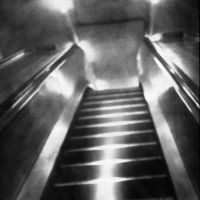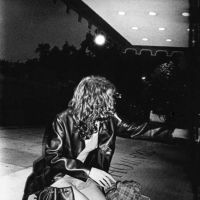The closest English photographer, and former night porter, Chris Shaw ever came to Japan was listening to stories at home in Merseyside from his Irish ex-merchant navy father. Sailor Shaw told his wide-eyed son of an extraordinary stopover in Osaka before the war in 1939, when he was granted shore leave.
Spotting some crowds, Frank Shaw soon found himself witnessing a momentous procession — remarkably, at the center, was Emperor Hirohito's coach conveying his status as the impeccable "living god." Then, suddenly a man ran across the street to steal a better view, but his timing was fatefully wrong and he cast a shadow over the Emperor.
"Immediately, in his shame, and only seeking a retribution for his dishonor," Shaw recalls his father's words, "the ill-fated spectator committed suicide on the spot."
Frank, too, had his own troubles that day. He was arrested for photographing without permission — this was junta ruled Japan after all — and had to be bailed out by his captain and a representative of Her Majesty's government.
Now Chris is about to follow in his father's footsteps, though he hopes not as far as incarceration, and soon will land in Japan, camera in hand, with a mission more directly aimed than his father's — to pay homage to the Japanese image masters who inspired him.
Images from Chris Shaw's celebrated book "Life as a Night Porter" — which won him the British Independent newspaper's prize for photography in 2004 — as well some of his more recent work, will be on show alongside some of Japan's iconic photographs at the Tokyo Photo 2011 fair.
It will be Shaw's first time in Japan; the visit a poignant one. As the photographer readily admits, the nation's finest camera work, such as Ikko Narahara's picture of a bin suspended in mid-air, impressed him so much when he first saw it that it drove him to become a photographer. That was in 1983, and it has been a hard slog since. But now the Englishman has attained his dream and Shaw's latest triumphant show, nestled within the Tokyo Photo event, is organized by Britain's prestigious Tate Modern gallery.
The show opens to the public on Sept 23 in the Tokyo Midtown Hall in Roppongi, and his collection of images will sit alongside the French Embassy's charity auction and photography exhibition, which has been curated in support of the victims of the Great East Japan Earthquake.
Shaw's show will be the centerpiece of the photo fair, and was specially commissioned by Tate Modern curator Simon Baker to highlight the power Japanese photography has over Western artists, and to share, compare and contrast Japanese aesthetics and technique with Shaw's own inky, brooding prints.
"Over 70 years on from my father's exploits, I'm excited by confronting the same subject," says Shaw in his classic Merseyside brogue. "As for the Japanese influence on my work, it's the shadow and light that is very important to me, though I have to say it (being sent to Japan) seems very much as if they are sending coals to Newcastle."
Ignoring Shaw's modesty, gallery goers are being given a rare chance to see the work of Japanese masters directly beside that of another maestro of capturing the fleeting world of the insubstantial and penumbral. Visitors will be able to draw comparisons with the Japanese perspective and catch up on three of Shaw's projects: "Life as a Night Porter," "Weeds of Wallasey," and "Sandy Hill Estate." Japanese prints juxtaposed alongside his work include those of Ikko Narahara, Daido Moriyama and other masters of the same oeuvre.
The "Night Porter" images alone are worth seeing. No one has ever depicted the murky, clandestine, nocturnal activities of our species from such a close stance, with many subjects far from home and sleep-deprived. Some shots have a twilight David Lynch "Eraserhead" quality, while others illustrate the photographer's wisecracking humor honed on sardonic Merseysiders.
A no-holds-barred once-impoverished photographer biography is also there: The penniless art student forced to work night shifts in hotels from New York to London. The human corruption, humor, violence, dissolution and sheer magic of an illuminated night.
After 10 years of working in hotels, Shaw found he had a bin-bag full of film to process, mostly taken with throwaway cameras. With such a tool there was no particular planned creative artifice. Yet from those dregs came the oddly privileged-view snapshots that led to Shaw's fame.
"I used the camera to keep myself awake to avoid being sacked," Shaw says. "The photographs became art because they documented that 'wonder of the chance meeting' and the social fantastic in a hotel at 3 a.m".
That aesthetic of captured fleeting moments is emphasized further by the Japanese photographic counterparts that Shaw pays homage to, making this a particularly fitting show for Tokyo Photo 2011- one that highlights both international and Japanese talent.
Tokyo Photo 2011 at Tokyo Midtown Hall in Roppongi, runs from Sept. 23 through Sept. 25, 11 a.m.-8 p.m., admission ¥1,300 (¥1,000 advanced purchase). For more information, visit www.tokyophoto.org. To find out more about Chris Shaw, visit www.chrisshaw.carbonmade.com.
Only in its third year, Tokyo Photo is still in its infancy, and like many other art-related events, including the relatively new ArtFair Tokyo and Roppongi Art Night, it was hit hard by the Great East Japan Earthquake of March 11.
"After the earthquake and tsunami, we lost several important sponsors., explains one of the fair's cofounders Takeshi Thornton. "But when the French Embassy approached us about a charity event, we felt we had sufficient momentum to hold the fair as initially scheduled."
Now back on track, the photographic international arena is heading for, its founders believe, further success.
When Thornton and his partner Tomo Harada established Tokyo Photo in 2009, it was the city's first international photo fair. The event attracted 5,000 spectators, a figure that doubled last year. It is set to hit 20,000 visitors this year.
"We want to energize and diversify the contemporary art market in Japan," says Thornton. "But we also want to enhance Tokyo's cultural landscape with a globally branded event that brings together the best galleries, museums, artists, and curators active today."




